
Catocala is a generally Holarctic genus of moths in the family Erebidae. The genus was erected by Franz von Paula Schrank in 1802. The moths are commonly known as underwing moths or simply underwings. These terms are sometimes used for a few related moths, but usually – especially when used in plural, not as part of a species name – they are used to refer to Catocala only.

Catocala fulminea, the yellow bands underwing, is a moth of the family Erebidae. The species was first described by Giovanni Antonio Scopoli in his 1763 Entomologia Carniolica. It is found in central and southern Europe, east Asia and Siberia. The xarippe lineage has been proposed to be a distinct and valid species in its own right, instead of being only subspecifically distinct.

Catocala retecta, the yellow-gray underwing, is a moth of the family Erebidae. The species was first described by Augustus Radcliffe Grote in 1872. It can be found in North America from southern Ontario and Quebec south through Maine and New Jersey, south through Tennessee to Georgia and west to Arkansas and Kansas and north to Wisconsin. There is one recognised subspecies, Catocala retecta luctuosa, which is sometimes treated as a valid species with the common name yellow-fringed underwing.
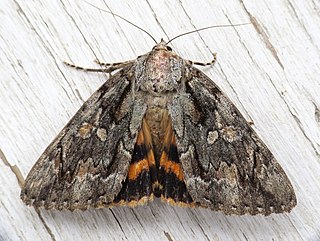
Catocala neogama, the bride, is a moth in the family Erebidae first described by James Edward Smith in 1797. It is found in North America east of the Rocky Mountains, from Maine and Quebec south to northern Florida and west to South Dakota, New Mexico, and into Arizona and Texas. Its westernmost population from the semiarid Colorado Plateau region is rather distinct and was once considered a separate species, but is now regarded as a well-marked subspecies C. n. euphemia.

Catocala meskei, or Meske's underwing, is a moth of the family Erebidae. The species was first described by Augustus Radcliffe Grote in 1873. It is found in North America from Maine and Quebec west to southern Alberta and Montana, south to South Carolina in the east and at least Montana in the west.
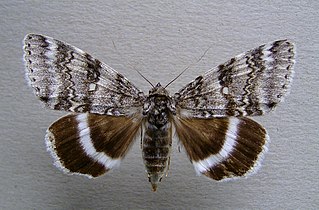
Catocala relicta, the white underwing or relict, is a moth of the family Erebidae. The species was first described by Francis Walker in 1858. It lives in southern Canada, from Newfoundland to Vancouver Island, south to Missouri, and Arizona.
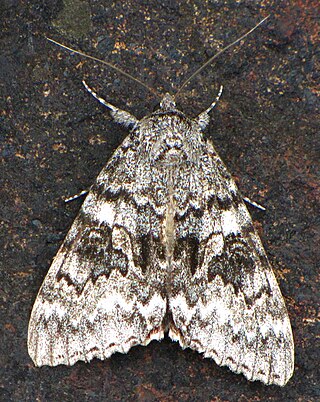
Catocala semirelicta, the semirelict underwing, is a moth of the family Erebidae. The species was first described by Augustus Radcliffe Grote in 1874. It is found in North America from Nevada, Colorado, Utah, California, and Nova Scotia south to Maine, west across Canada to British Columbia, and southward in the mountains.
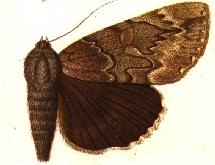
Catocala residua, the residua underwing, is a moth of the family Erebidae. The species was first described by Augustus Radcliffe Grote in 1874. It is found in North America from southern Ontario, Quebec and Maine south to North Carolina and Georgia west to Mississippi and Missouri and north to Iowa, Illinois and Michigan.
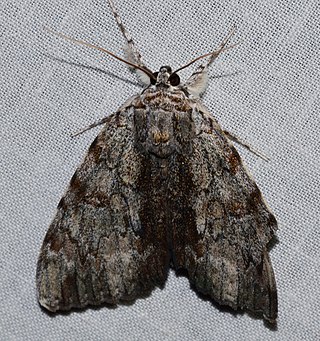
Catocala insolabilis, the inconsolable underwing, is a moth of the family Erebidae. The species was first described by Achille Guenée in 1852. It is found in North America from Ontario through Maine and Connecticut south to Florida, west through Arkansas to Texas and Oklahoma and north to South Dakota.
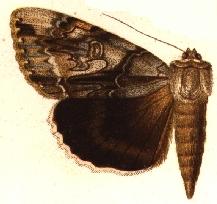
Catocala vidua, the widow underwing, is a moth of the family Erebidae. The species was first described by James Edward Smith in 1797. It is found in North America from southern Ontario, into Maine, New Hampshire and Connecticut, south at least to Tennessee, Georgia and Alabama, west to Texas and Oklahoma, and north to Wisconsin.

Catocala badia, the bay underwing, bayberry underwing or old maid, is a moth of the family Erebidae. It is found from southern Maine and New Hampshire south to New York and Connecticut.

Catocala palaeogama, the old wife underwing, is a moth of the family Erebidae. The species was first described by Achille Guenée in 1852. It is found in North America from Ontario and Quebec, through Maine, New Jersey, Tennessee, to South Carolina, west to Arkansas and Oklahoma and north through Iowa, Indiana, Illinois and Michigan.

Catocala subnata, the youthful underwing, is a moth of the family Erebidae. The species was first described by Augustus Radcliffe Grote in 1864. It is found in North America from Manitoba, Ontario, Quebec, and New Brunswick to Nova Scotia, south through Maine and Connecticut to North Carolina and west to Tennessee, Kentucky, and Texas, then north to Iowa, Wisconsin, and Michigan.
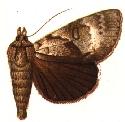
Catocala andromedae, the Andromeda underwing or gloomy underwing, is a moth of the family Erebidae. The species was first described by Achille Guenée in 1852. It is found in the United States from Maine south through New Jersey to Florida and Alabama and west to Texas and Oklahoma.
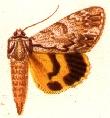
Catocala gracilis, the graceful underwing, is a moth of the family Erebidae. The species was first described by William Henry Edwards in 1864. It is found in North America from Manitoba to Nova Scotia and Maine, south through Connecticut, New Jersey to Florida and west to Mississippi and Missouri.

Catocala crataegi, the hawthorn underwing or chokeberry underwing, is a moth of the family Erebidae. It is found from Ontario and Quebec to Prince Edward Island south from Maine through Connecticut to Georgia and west to Arkansas and north to Minnesota.

Catocala grynea, the woody underwing, is a moth of the family Erebidae. The species was first described by Pieter Cramer in 1780. It is found in North America from Ontario and Quebec through Maine and Connecticut, south to Florida, west to Texas and north through Iowa to Wisconsin and Minnesota.

Catocala similis, the similar underwing, is a moth of the family Erebidae. The species was first described by William Henry Edwards in 1864. It is found in North America from Ontario and Quebec south through Maine and Connecticut to Florida, west to Texas and Oklahoma, and north to Minnesota.

Catocala sordida, the sordid underwing, is a moth of the family Erebidae. The species was first described by Augustus Radcliffe Grote in 1877. It is found in North America from Saskatchewan east to New Brunswick and Prince Edward Island and south through Maine and Connecticut to Florida, west to Texas and north to Manitoba.











